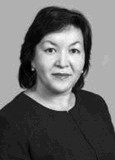Bioimpedance indicators of combat athletes depending on the somatotype
Keywords:
athletes, martial artists, Yakutia, somatotype, Ries-Eysenck index.Abstract
Objective of the study was to establish bioimpedansometric indicators of the body of combat athletes in Yakutia, depending on the somatotype according to the Ries-Eysenck index.
Methods and structure of the study. A total of 49 Yakutia combat athletes of high sports qualifications were examined. An anthropometric examination was carried out. Bioelectrical indicators and body components of athletes were determined by bioimpedansometry using the ABC-01 Medass apparatus. The protocols contained an assessment of fat mass, active cell mass, skeletal muscle mass, lean mass, active and reactive tissue resistance measured at a frequency of 5 and 50 kHz, as well as the phase angle. Body mass index was calculated. Somatotyping was carried out using the Ries-Eysenck index.
Results and conclusions. It has been determined that as the weight category increases, the value of the absolute, relative fat component and the absolute value of the musculoskeletal component of the body increases. Establishing the somatotypological and bioimpedance characteristics of an athlete will help to personalize training loads, reduce the risk of sports injury in order to achieve high sports results.
References
Kulemzina T.V., Krasnozhon S.V., Shakula A.V. Konstitutsionalnyy podkhod kak faktor profilaktiki sportivnogo travmatizma. Vestnik vosstanovitelnoy meditsiny. 2021. Vol. 20. No. 6. pp. 34-39.
Nikitushkin V.G. Novyye aspekty metodiki otbora i sportivnoy trenirovki v yedinoborstvakh. Vestnik sportivnoy nauki. 2022. No. 5. pp. 9-13.
Nikolaev V.G. et al. Ocherki integrativnoy antropologii. Krasnoyarsk: KrasSMU publ., 2015. 326 p.
Nikolaev D.V., Rudnev S.G. Sostav tela i bioimpedansnyy analiz v sporte (obzor). Sportivnaya meditsina: nauka i praktika. 2012. No. 3. pp. 34-41.
Petrov D.V. Osobennost postroyeniya trenirovochnogo protsessa v bodibildinge s uchetom razlichnykh somatotipov sportsmenov. Sovremennoye pedagogicheskoye obrazovaniye. 2021. No. 2. pp. 140-142.
Pigul P.G., Kurnosova V.A., Melnov S.B. Osobennosti issledovaniya predraspolozhennosti k sportu vysokikh dostizheniy. Uchenyye zapiski Belorusskogo gosudarstvennogo universiteta fizicheskoy kultury. 2022. No. 25. pp. 189-193.
Pronin E.A., Anisimov M.P., Fadeev A.S., Maksimov V.N. Analiz primeneniya nauchnykh podkhodov dlya razvitiya silovoy vynoslivosti u sportsmenov-girevikov s uchetom somatotipa. Pedagogicheskiy zhurnal. 2022. Vol. 12. No. 4-1. pp. 545-552.


